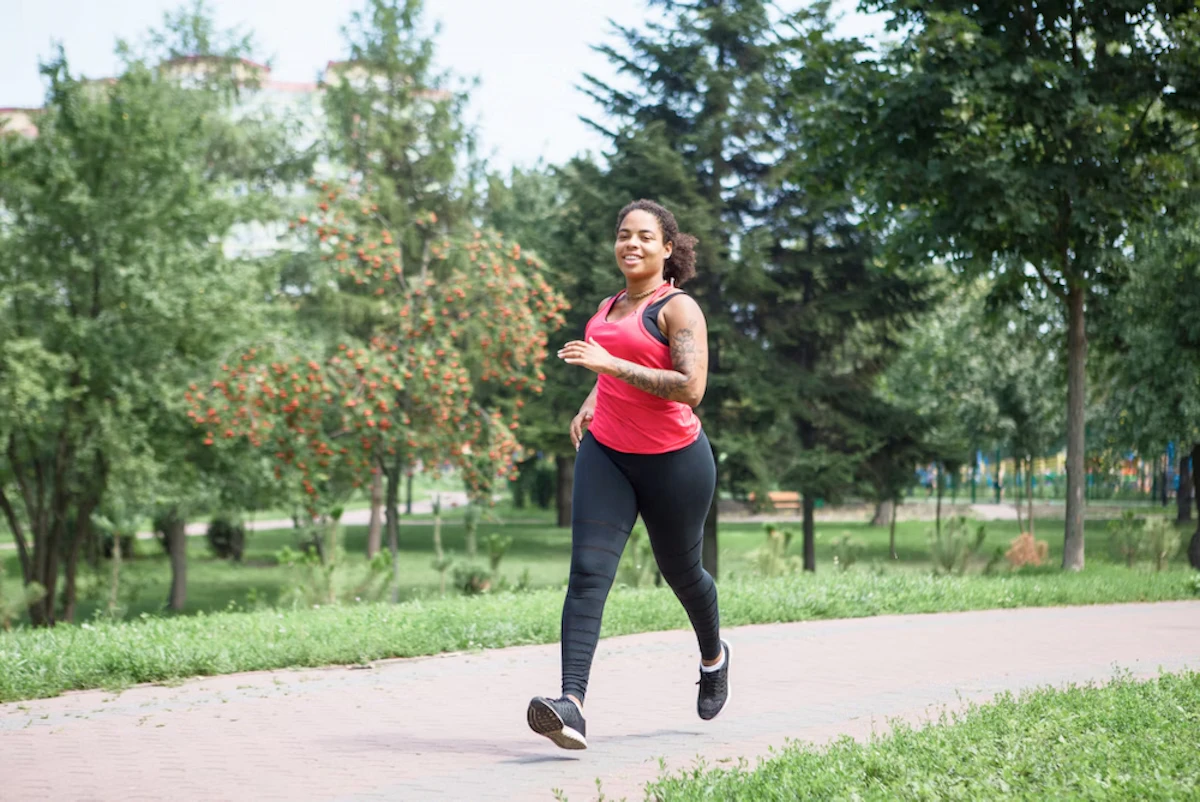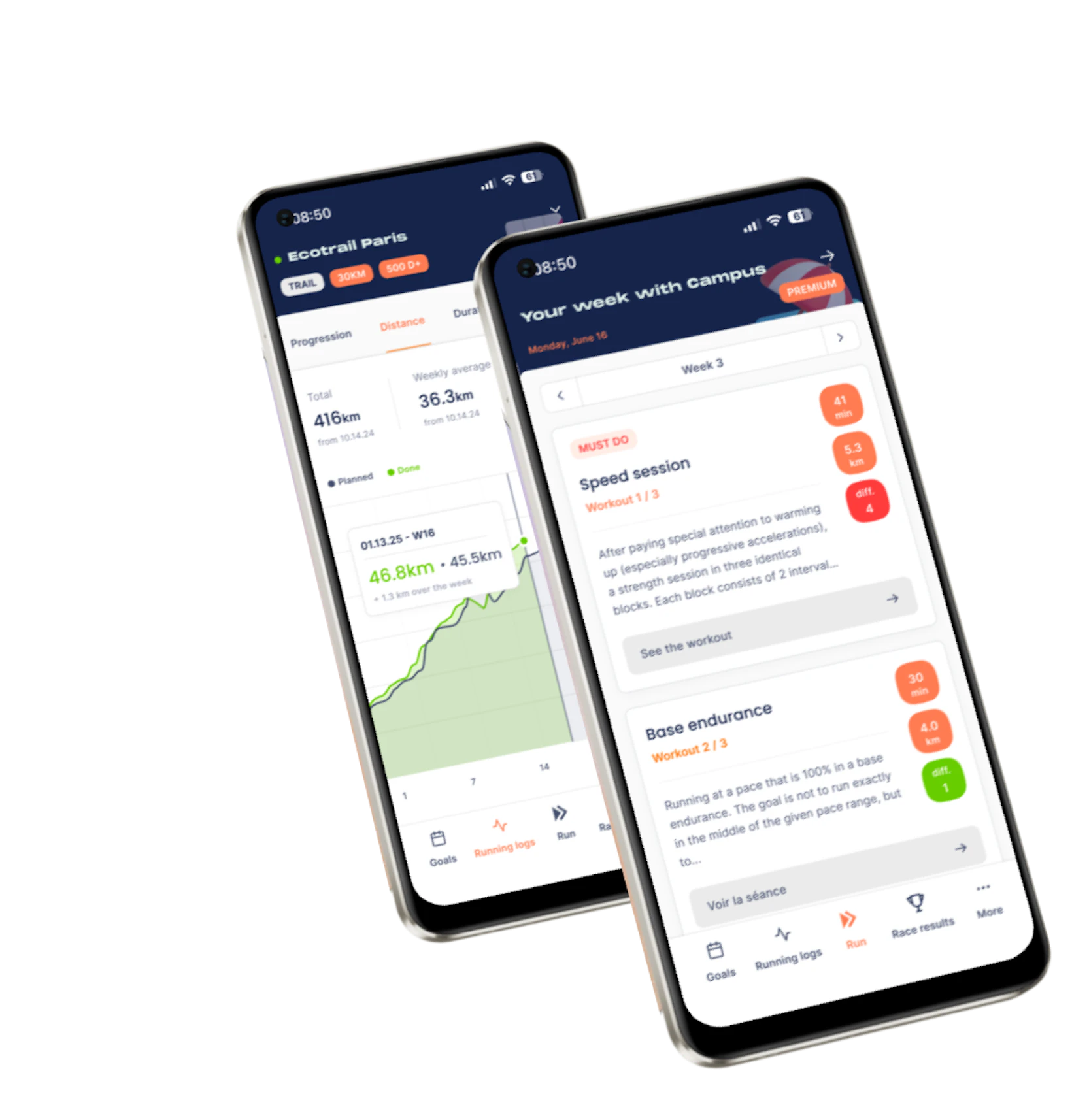What training plan for the half-marathon is most suitable for a beginner?

13 min read
Summary
Preparing to run a half-marathon distance as a beginner
🤔 How many training sessions per week to succeed in your half-marathon?
🔎 What weekly running volume to start a half marathon?
🔢 1:30 ? 1:40 ? 1:50 ? 2:00 ? 2:10 ? What time and pace to aim for a first half-marathon?
How to train for a
Priority to general development
What workouts are in your half-marathon plan?
🏃🏽♀️ Improving your base endurance to prepare for a half-marathon
⌚ Long runs
💨 Intervals, fartlek, and 30' threshold
💥 Half-marathon specific pace
What additional ingredients to include in your preparation to finish a half-marathon? Our training advice.
How much time to dedicate to your half-marathon preparation? What beginner half-marathon training plan should you choose?

Receive advice from our passionate coaches!
Do you know which distance is most commonly run in France? It's the half-marathon. There are several objective reasons for this. The half offers a good balance between the intensity of effort and endurance. Running 21.0975 kilometers is a motivating challenge, and the barrier to entry is lower than in a marathon. At Campus, we are convinced that the half-marathon is an accessible distance for everyone, provided they put in the effort. This includes a structured and tailored beginner's half-marathon training plan that suits your capabilities. We'll provide the key elements to follow and some tips. 🗒️
Preparing to run a half-marathon distance as a beginner
Not all beginners have the same starting level. We can identify different profiles. If you've never run and haven't done sports in years, you'll likely find it difficult to run for 30 minutes straight. In this case, opt for a gentle and progressive discovery running plan. This kind of plan will start you with an alternation between walking and running. Our Campus beginner running plans, ranging between 4 and 12 weeks, have been created especially for your profile. We will accompany you to running 30 minutes non-stop, or even more. After that, you'll be better prepared to tackle preparing for a half-marathon. An alternative is to choose a long-duration half-marathon plan, between six and twelve months.
If you are already able to run about thirty minutes without difficulty and run regularly, you can directly start a “classic” half-marathon preparation.

🤔 How many training sessions per week to succeed in your half-marathon?
There's no secret. The first key to progress in running is to run regularly. Having a good training frequency is important because the body reacts much better to smaller regular stress than to larger stress spaced further apart. It's a good way to generate adaptations while enhancing recovery.
Practically, below three training sessions a week, it will be difficult for you to progress in the long term. To prepare for your half-marathon, it's the minimum required. If possible, add a fourth session, which could be a relaxed jog. This will encourage better distribution of your training load throughout your week.
🔎 What weekly running volume to start a half marathon?
After frequency, the weekly training volume is the second key pillar of progress. A good running volume will help you develop your cardio and strengthen your body (muscles, tendons, joints) as well as your mental strength. 💪🏾
As a beginner, the volume of your first weeks will be deliberately very low. We want to ensure you do not exceed your assimilation capacities and minimize the risk of injury as much as possible. Then, the increase in distances will be very gradual (+10 to 15% maximum per week). After three weeks of increasing the load, you'll schedule a lighter or assimilation week before starting another progressive block of three weeks.
For a first half-marathon, the minimal weekly volume involves covering at least the event distance, 20 to 25 kilometers, for a few weeks.
To prepare your half marathon under better conditions, it's advised to aim for a slightly higher volume, around 35 to 40 kilometers at the peak of your preparation. Then, your training volume will decrease during the last two weeks of the plan. That's the tapering (see below).
🔢 1:30 ? 1:40 ? 1:50 ? 2:00 ? 2:10 ? What time and pace to aim for a first half-marathon?
The main goal when discovering a new distance in endurance is to successfully complete the race in good conditions. It comes before the clock. However, it can be motivating to set a time goal, provided it matches your capabilities and the resources you can deploy during your preparation.
Starting by setting yourself a goal, such as completing your half-marathon in two hours, and then following the corresponding plan, is approaching the issue backwards, especially if you have no sense of training. 🙃
The best approach is to adapt your beginner half-marathon training plan to your profile as closely as possible. Then, we'll help you set an achievable goal, which can evolve during your preparation. Progress is often rapid for beginners who follow a structured training for the first time.
If you have some time benchmarks on shorter distances than the half-marathon, you can use our pace calculator to estimate your potential time. We have also dedicated a full article on how to estimate your time on a half-marathon.
How to train for a half-marathon as a beginner? The different stages of half-marathon training.
A well-structured preparation always involves three major phases: the general development, the specific development, and the tapering. For you, as a beginner, we will emphasize the first one.

Priority to general development
➡️ The first part of your beginner half-marathon training plan is called the general development phase. It is crucial for beginners. This will be the longest phase of your preparation. We will aim to build the strongest possible foundation and to harmoniously develop your physiological and physical capabilities. In other words, enhance both your engine and your bodywork. 🏎️
The concept of progression is important. The shocks generated by running are traumatic for your lower limbs if you're not ready to absorb them. We will start very gently, with small jogs. Gradually, adaptations will start to form. Your body will strengthen and accept increasingly demanding loads. We will then be able to increase the workout difficulty by adjusting the two main levers: training duration and intensity (speed).
During the general development phase, we also play with the variety of workouts to diversify the stress and adaptations. A common mistake seen among beginners is always running at a medium intensity zone. On the contrary, you must vary your pace and effort intensities and know how to rest between the most intense workouts.
➡️ The second phase of your beginner half-marathon training plan, known as specific development, will include workouts with a half-marathon pace. This specific development phase is shorter for beginners than for advanced athletes. Indeed, we're not primarily aiming for performance optimization. The main goal is to build your confidence to run at this pace. You must believe in your ability to reach the finish line.
➡️ Finally, ten days before your race, it's time to start the last phase of your preparation: tapering. We gradually lower the overall volume of your training — around 75% of the usual volume at S-2, then 50% at S-1. The goal is to reduce your fatigue level and to arrive well-rested on D-day. If you have respected your tapering period well, everything will seem much easier than in training. 👌
What workouts are in your half-marathon plan?
Your training plan includes several types of workouts. It's time to get to know each of them. 🤝
🏃🏽♀️ Improving your base endurance to prepare for a half-marathon
It might seem counterintuitive, but the most important thing when starting to run is to learn to run slowly. Most of your overall training volume should be done at a comfortable breathing pace. We talk about base endurance because this effort intensity, below 75% of your Maximum Heart Rate, is essential for building good endurance and balancing your beginner half-marathon training plan.
⌚ Long runs
There is no lower limit for long runs. They are just longer than your usual jogs. If you usually run for 30 minutes, a 40-minute session is already a long run as it represents 33% more than your jogs. Their duration will very gradually increase during your half-marathon preparation — maximum 10 minutes more each week — until reaching 1 hour 30 to 1 hour 40. Regardless of your goal for the half-marathon, it's not recommended to run longer as it would affect your recovery.
💨 Intervals, fartlek, and 30' threshold
VO2 max is the maximum volume of oxygen your body can use during effort. It represents your engine capacity. It's a good indicator of your fitness level and your athletic abilities. The higher your VO2 Max, the greater your potential will be over any distance. This performance factor is easily improvable when starting running by doing high-intensity workouts. So take advantage of it! 🥳
In these high-intensity workouts (> 90% of your Maximum Heart Rate), you will find a multitude of sessions: short and long intervals on track or road, fartleks in nature, sessions around your 30 and 60 minute thresholds, and many more. The principle is to push your cardio for longer or shorter intervals, with recovery phases. These high-intensity workouts will also help you to free up your stride. After experiencing high paces, you'll feel more at ease at the half-marathon pace.

💥 Half-marathon specific pace
In preparation, we move from less specific to more specific. Once your base endurance is acquired and you've developed your speed, we can move on to pace work.
These are sessions including intervals run at your half-marathon target pace, such as 4 x 2000 meters or 3 x 3000 meters, with some minutes of base endurance recovery between each interval.
The half-marathon pace is comfortably hard. At no time should you push yourself too hard. ❌ For a beginner, it's already very good to maintain 80% of their Maximum Aerobic Speed or 85% of their Maximum Heart Rate for 21.0975 kilometers.
Keep in mind that the lower your initial level, the closer your< em>half-marathon pace will be to your base endurance pace. Remember that as a beginner, covering 21.0975 kilometers is a great achievement, regardless of your pace.
What additional ingredients to include in your preparation to finish a half-marathon? Our training advice.
The number one goal of any runner is to avoid injuries and arrive in the best possible condition on race day. Strength & conditioning, stretching/stretches, and fitness are good ways to protect your tendons and joints and address some imbalances. You can do them at home with very little equipment. We also think about joint mobility. Just a short 5-minute mobility routine is beneficial before going for a run. Then, cross-training is interesting, particularly if you are regularly prone to injuries. By practicing a supported sport like swimming or cycling, you will develop your endurance without generating mechanical stress.
How much time to dedicate to your half-marathon preparation? What beginner half-marathon training plan should you choose?
You now know the major phases and key elements of a half-marathon preparation.
➡️ If you're not starting from scratch, 12 weeks of half-marathon training is a strict minimum. This timeframe remains very short to build a good endurance base. Over the twelve weeks, you can dedicate eight to general development and the following four to specific development and tapering. In reality, this duration is more suited for runners already experienced in the half-marathon distance or possessing very good physical condition and strong endurance.
➡️ To prepare for your half-marathon in better conditions, lean towards at least 16 to 20 weeks of preparation. This way, you can thoroughly focus on the phase of general development by being very gradual in increasing loads and genuinely raising your capacity as a runner. At Campus, we are convinced of the benefits and advantages of long-term plans. It must be said that long-term plans promote better progression and allow for working on a greater variety of skills. You will have time to build a stronger foundation. Rest assured, a long-term plan is not synonymous with boredom. To mix up the fun, we invite you to place at least one preparatory 10 km race before your half-marathon. You will approach these 10 kilometers as a real-life workout to test your gear, nutrition, and hydration. You will also notice that the race effect is not a myth. In the race, you feel like you're truly soaring. 🪽

As you understand, there is no one ideal recipe for preparing your first half-marathon as a beginner, but there are still some key elements to follow, such as integrating three or four training sessions a week, being very progressive until you're capable of running for 1 hour 30 to 1 hour 40 consecutively, covering at least the distance of the half-marathon in a training week, and more.
Depending on your starting level, the process will take more or less time. Sixteen to twenty week half-marathon plans offer a good compromise for most beginners. The Campus programs allow you to choose your goal level based on your mindset: enjoyment, mix, or performance. Now, it's your move! 😎











